Food Subculture Club visits a raw food (un)cooking workshop
November 13, 2005
When cooking with meat or dairy, it’s always easy to create foods that are delicious, rich and complex in flavour. By combining processed grain flours with an oven, or brown rice and a rice maker, it’s simple enough to make comfort food. But I have always been curious as to whether a diet of raw food could fulfill the very normal culinary hunkerings for diversity and satisfaction. By this I mean, the potential nutritional benefits of eating a raw food diet aside, is it possible to make an interesting raw food repetoire that is well-suited to the Northern European winter?
On my cookbook shelves there are two cookbooks about raw food cuisine; Roxanne Klein & Charlie Trotter’s R A W, and Juliano Brotman’s Raw, the UNcookbook. I had tried several recipes from R A W, but found that I always had to ‘pump up the volume’ to make them palatable. I found it difficult to incorporate these recipes into a dinner in which the other dishes required cooking. Some dear friends of mine had given me Juliano’s Uncookbook, but I had never used it for anything other than looking up soaking times for nuts. The amount of ingredients for any given recipe just seemed too long to be feasible. When I heard that raw food chefs Juliano Brotman and Ariel from Santa Monica’s Planet Raw were coming to give a week of workshops I was most enthuasiastic to be able to participate.
Just from a culinary prespective…
The workshop, held in an anti-squat in exceedingly picturesque Broek in Waterland just north of Amsterdam, ended up having a lot in common with one of Louis Theroux’s Weird Weekends, except that I’m nowhere near as charming as Louis is/was and the workshop was in the middle of the week. During the introductions I inadvertently started things off on the wrong foot by not giving the correct answer to the question, ‘how raw are you?’ My answer, ‘Pretty dang raw, but I’m not a vegetarian’ caused more than a few of the other participants to gasp audibly. I could have known that by trying to explain my omnivorous culinary bend that I would become the pisspole of raw food guru-ji Juliano.
Personal affinities aside, it is only fair to mention that I found all of the food that we prepared in the workshop to be ‘rock my world’ delicious and most of my prejudices with regard to this subculture’s cuisine were quickly dispelled. The food wasn’t all wet and cold, it didn’t taste like ‘health food’, it didn’t taste like vegan food, it was neither bland nor monotonous. In fact, at the end of the workshop, I really started getting cravings for something SIMPLE, like a piece of undressed lettuce. Juliano prepares foods like a parfumier makes a scent. He composes flavours and textures out of his ingredients. His knowledge of the flavour characteristics and textures of the ingredients he uses is impressive. Were it not for this fact, I would have been so out of there, having very little tolerance for statements like ‘cooked food is pure poison’, and ‘I know someone that has been raw for six hundred years’. There was an unspeakable culture clash, but boy can this guy (un)cook.
One of the things I appreciated most about the workshop is that due to Juliano’s conviction that everyone in the entire world should become ‘raw’ immediately, he was eager to explain a feasible methodology for running a raw food kitchen and/or household. I had reported earlier that raw cuisine is labour intensive, and compared to throwing ingredients into a rice maker or grilling up some flesh, it is, but Juliano explained how to make some basic ingredients that could be worked into meals over a period of a week that made the idea of raw food meal preparation less daunting.
Please click ‘please read more’ to see an interview that I conducted with Juliano and Ariel that will probably answer some of your burning (sorry) raw food questions.
6 Questions for raw food chefs Juliano Brotman and Ariel: 03.11.2005, Broek in Waterland, Nederland
Q1. On substitution. You possess a skill for bringing out the inherent flavours and textures of foods. I would describe your style as more that of a parfumier in that you combine foods to create new flavours and textures. But you work towards creating substitutions of foods from the repetoire of the omnivore by using terms like mayonnaise, meat and bread. Why do you choose to contextualise your recipes in terms of meat-world substitutes?
All questions answered by both Juliano and Ariel.
A1. We use the names of non-raw foods as a strategy to make the raw foods more accessible to our customers, some of whom are not even vegan. We place the foods in a cooked foods context because we know that otherwise a lot of people wouldn’t even taste the food. Once people have tasted the foods they usually think it is delicious, but terms like ‘bread’, ‘mayo’, and ‘meat’ offer a frame of reference.
Q2. On preserving nutritional value. When using a dehydrator you use 120°F/~49°c as the cut-off temperature for heating or drying foods and still keeping them raw. But sometimes your recipes call for dehydrating (albeit at low temperatures) for many hours, sometimes even days. I always liken the dehydrator to taking a sauna. If I put myself into a sauna for many hours, my muscles won’t work very well (which is also a sign of the presence of enzymes). Are the enzymes still present in say, carrot pulp, flax, and buckwheat sprout crackers that have been in the dehydrator for 4 hours?
A2. *Freezing and dehydrating foods removes 50% of a foodstuff’s initial nutritional value, sunlight adds 50% to the nutritional value of foods. Our knowledge about how much nutritional value is retained after food preparation is intuitive. (ed. Thank you for being so forthcoming about the intuitive nature of your nutrition knowledge!)
Q3. On sustainability. How would you respond to the statement that a raw food diet is actually ‘bad’ for the planet in terms of it’s sustainability. By this I am referring to the long distances that cocoa nibs, hemp seeds, palm oil and many of the commonly used ingredients must travel before they make way into the raw foodists kitchen or marketplace, but also the high ‘processing time’ of the foods, e.g., 16 hour dehydrator drying times. How do you respond to this without making a comparison to a typical North American diet as a starting point (don’t compare bad to bad)? Can you imagine a diverse locative raw food diet in a location where there are no nuts, for example? Is there such a thing as ‘locative raw’?
A3. We are consumers! But seriously, we run a restaurant. Obviously Thai coconut is not an ingredient that we condone eating everyday if you don’t live in the jungle, but we try to keep to a minimum the use of non-local ingredients in our food to a minimum. But it is important to remember, a restaurant is a showcase for a specific cuisine and lifestyle, and therefore does not imitate the home kitchen.
Q4. On exclusivity. Poor people, and more importantly, the traditional kitchens of cultures that have known hunger, (that is to say, most comfort foods from any culture) are typically high starch, high glycaemic foods. How would you respond to the statement that a raw food diet is exclusively for the rich? I am referring to the high-protein, low glycaemic and fresh food rich content of the diet, plus the relatively (compared to picking up FastFood) labour intensive preparation. Can you imagine making a recommendation for a healthy diet for the less privileged?
A4. If you try to pursue a raw food diet you will succeed in doing so, no matter what your income is. During the closing times of farmers’ markets, it’s always possible to get food for free in the worst case scenario.
At this point I challenged J&A by asking them if they could design a raw food diet for a housecleaner, to which Juliano and Ariel replied, ‘Our maid and her daughter have been raw for 6 months and they are extremely positive about it. She went to the movies with her daughter and saved eight dollars by not buying popcorn, candy and junk food, for example. That is savings. It all depends on how you think about saving money, in the short term or the long term. If you consider the long term health benefits of a raw food diet, your savings will be substantial as you get older and older. This is outside the quality of life issues associated with a raw food diet.
Q5. On the future. Your first book, RAW, the uncook book, describes a basic food preparation method, a coherent set of recipes and a lifestyle. What have you developed since it’s publication that you will include in your new book coming out in the Spring of 2006 in terms of; methodology, lifestyle, and recipes? Do you have a map for your culinary direction?
A5. Our new book is coming out in the Spring and you can read about all of our newest developments there. We hope you buy it. Because of our new West L.A/Beverly Hills location, the food has become more ‘nouvelle’ style.
Q6. On health. Your list of foods in the ‘nono’ group includes all fruit hybrids including figs, bananas, dates, and most grains and beans. At what point do you deem foods to be healthy in light of the fact that you also sometimes choose for flavour? (By this I don’t mean to point to inconsistencies in your philosophy.) Why exclude hybrids?
A6. We are chefs and we feel that using a few drops of nama shoyu, roasted sesame oil, balsamic vinegar is a matter of personal taste and choice. These small amounts will not kill you.
_____________________________________________________________________________________________
*I will not delve into the scientific/health issues associated with the subculture of raw food because there I can find no locus of concensus on nutritional values. I do believe that one can eat a varied raw food diet and one that is provides the recommended daily allowances of vitamines, minerals, protein, fats and carbohydrates for adults.
Unanswered Question: In raw food cooking one endeavours to preserve the nutritional potency of the food by not cooking it. Dehydrating and soaking aside, how much nutrition can one really absorb in one meal?
debra at 20:31 | | post to del.icio.us

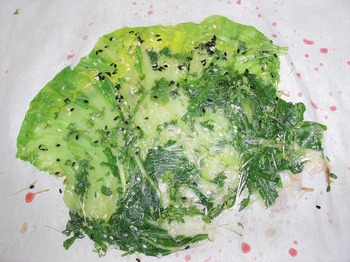
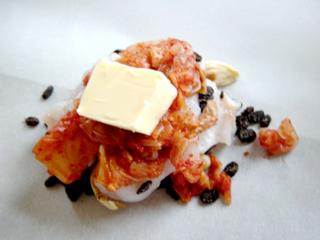
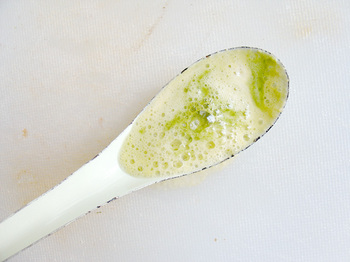
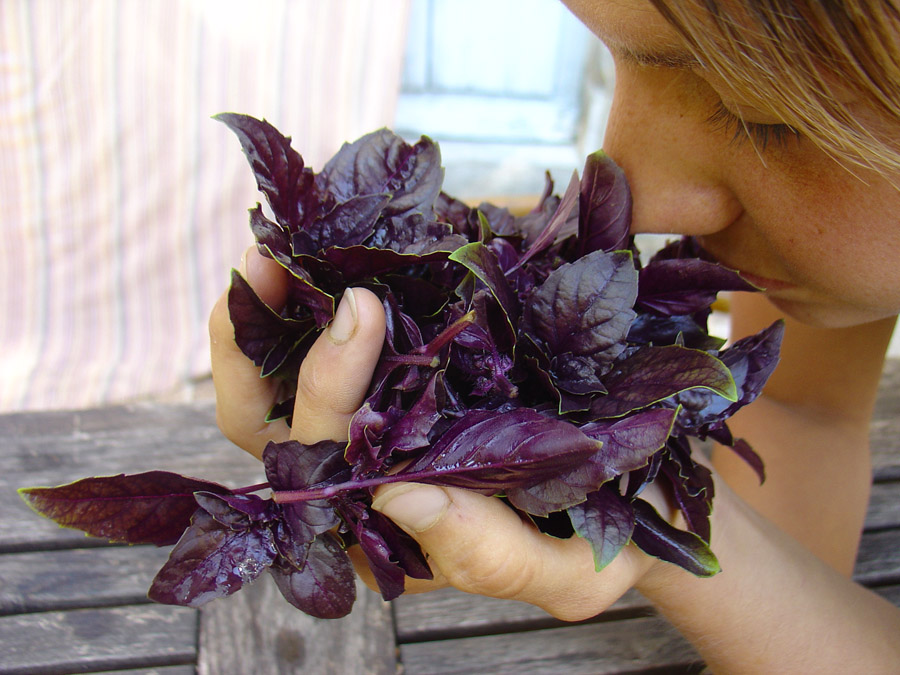
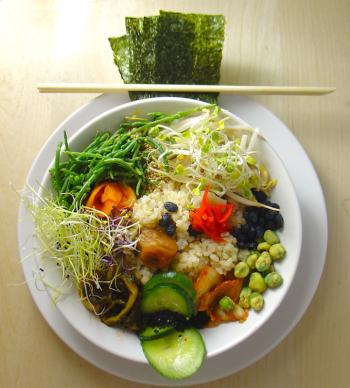
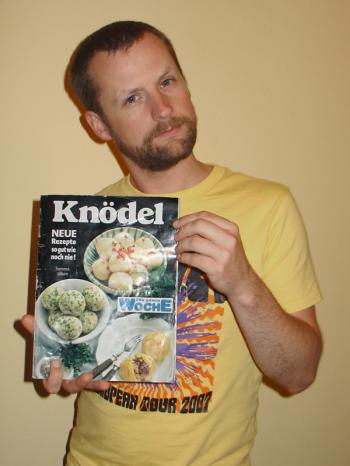
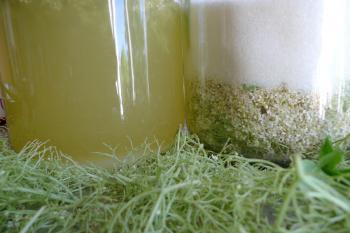







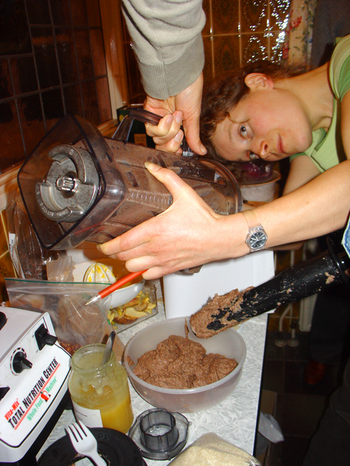
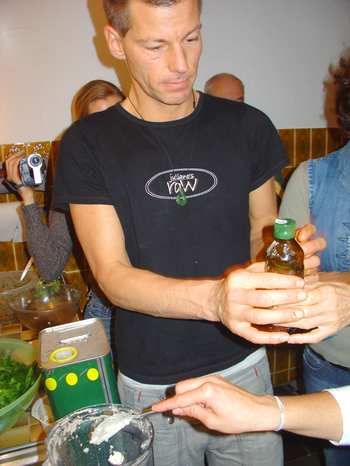
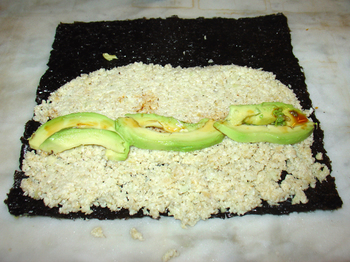



Thanks so much for this post. I’ve been raw since January 1st 2006 and am at a point where I want to expand my menu and need ideas. I used to think that raw culinary classes would be unnecessary, but it’s been easy for me to fall into a limited menu just because I haven’t ventured beyond the common vegetables I’ve been used to. Perhaps I’ll find such a class near me someday.
-Allison
Allison’s Raw Odyssey
Comment by Allison — January 23, 2006 @ 3:05
I love juliano and everything hes about .When and where can I get his new book? It is fall 2007 and I have not seen it on longisland NewYork Is it out yet? and whay is the title? thanks Diane
Comment by diane — October 17, 2007 @ 3:22
Juliano’s genius with basic ingredients is inspiring and I’d love to incorporate some of his raw methods into my diversified lifestyle. However, I must ask you to forgive my cynicism when I say this: It strongly seems that Juliano evaded answers to your questions regarding environmental sustainability and average-joe attainability. Even if he answered honestly from his perspective, I am not at all satisfied and I hold the opinion that he ought to get off his elitist high-horse and try maintaining decent raw nutrition for under five Santa Monica dollars a day. Lucky for him that California has such diverse agricultural capabilities or I’d challenge a local diet to boot.
P.S.: Your blog is awesome!
Comment by spicecat — August 21, 2009 @ 7:27
Spicecat,
I wholeheartedly agree with you regarding the elitist BS. We must remember that there are many different roles to play and that Juliano’s talent lies in his extreme ability to work with raw ingredients. He is less talented at being a spokesperson for a ‘movement’ that doesn’t really need to be a movement.
In the years since I first met Juliano, I’ve had occasion to work with many open air markets and directly with the waste flow of these markets. Maybe you’re already aware of the amount of ‘left over’ produce. One could easily have a tropical raw food diet from this food flow - if motivated to do so.
Indeed I agree that healthy solutions that apply to larger groups of people are the most interesting but I am thankful that chef’s like Juliano devote themselves to making a small set of foods highly palatable. People like me or you can reapply these recipes for projects that we think will be valuable for a larger population. This is OUR talent.
Glad you like the blog. I love to hear it, so thanks!
Warm regards,
Debra Solomon
Culiblog.org
Comment by Debra — August 21, 2009 @ 12:17